Manitoba Insect and Disease Update: July 9, 2014
Compiled by:
- John Gavloski, Entomologist
Manitoba Agriculture, Food and Rural Development
Phone: (204) 745-5668
Fax: (204) 745-5690. - Vikram Bisht, Plant Pathologist
Manitoba Agriculture, Food and Rural Development
Phone: (204) 745-0260
Fax: (204) 745-5690
To report observations on insects or plant pathogens that may be of interest or importance to farmers and agronomists in Manitoba, please send messages to the above contact address.
To be placed on an E-mail list so you will be notified immediately when new Manitoba Insect and Disease Updates are posted, please contact John Gavloski at the address or numbers listed above.
To be placed on an E-mail list so you will be notified immediately when new Manitoba Insect and Disease Updates are posted, please contact John Gavloski at the address or numbers listed above.
Summary
Leaf rust spots have been observed in fall rye as well as a few spots resembling Septoria leaf spot. Blackleg spots can be found on canola foliage. A few armyworms have been noted in wheat in the eastern part of Manitoba, but not at levels that could be economical.
Rye
Leaf rust was observed in fall rye plants in western Manitoba. The disease is wind borne, and conditions of high humidity and warm temperatures could support dispersal and infection of other fields.
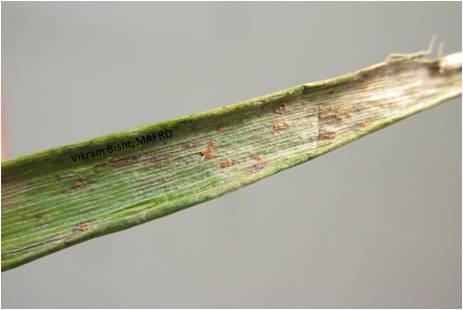
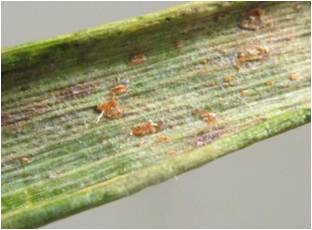
Fig.1a. Leaf rust spots on fall rye, 2014. Fig.1b. Close-up of Leaf rust spot.
Photo courtesy: Vikram Bisht, MAFRD Photo courtesy: Vikram Bisht, MAFRD
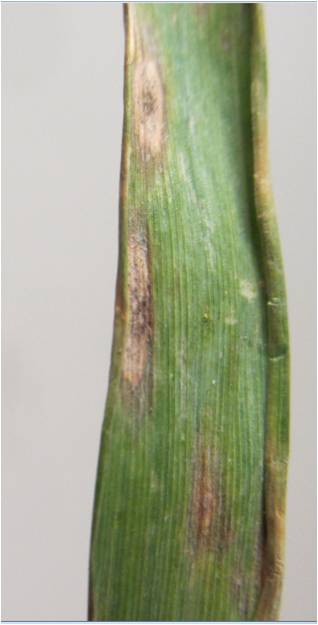
Fig. 2. Septoria leaf spot on rye. Note the pycnidia in the center of the spots.
Photo courtesy: Vikram Bisht, MAFRD
Soybeans
Brown spot disease (Septoria) continues to be seen in many more fields. Sometimes fomesafen (Reflex) herbicide injury appears similar to brown spot; but is present only on upper leaves, unlike brown spot which is currently appearing mostly on the lower leaves. The herbicide is contact type, and will show injury only on those leaves present; the leaves emerging later will not show spotting.
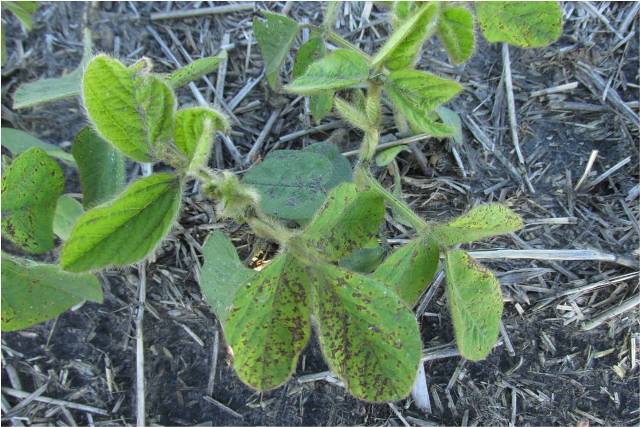
Fig. 3. Fomesafen (Reflex) injury appears similar to Brown spot disease, but newer leaves will not show spotting. Photo courtesy: Vikram Bisht, MAFRD
Canola:
Blackleg spots on canola foliage is showing up in many fields, including varieties that are R-rated for blackleg. R-rating indicates high level of resistance (not immunity) against the strains that they have been tested for. With changing dynamic of the strains of the Leptosphaeria fungus, some R-rated varieties may show in some regions more than normal blackleg disease.
Downy mildew may be seen in a few fields (Fig 5). Downy mildew is favoured by high humidity and warm temperatures; and in high humidity shows sporulation on the underside of leaves. Downy mildew is normally a minor disease.
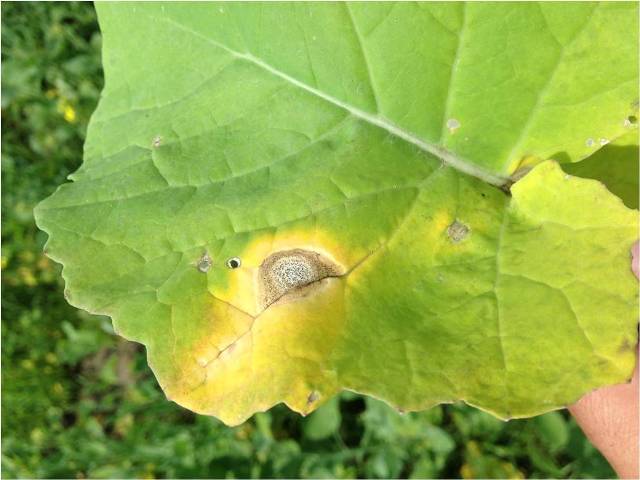
Fig.4. Blackleg spots on canola foliage, 2014. Photo courtesy: Tao Wang,Cargill AgHorizons
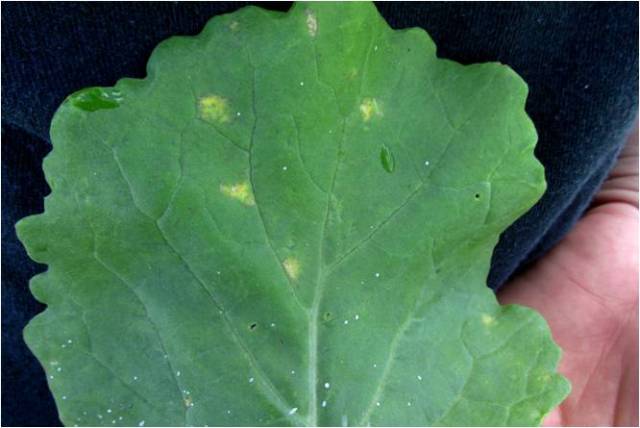
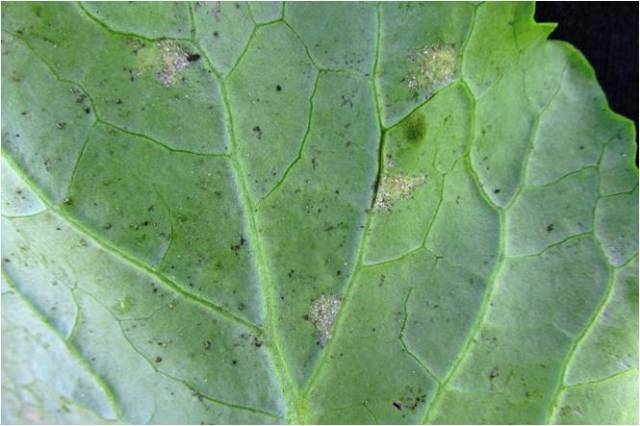
Fig.5. Downy mildew spots on canola leaf- upperside and same spot on underside, 2014. Photos courtesy: Vikram Bisht, MAFRD
Wheat:
Minute tan spots are showing up on flag leaves in a few fields. Some of these fields have just started flowering. In such fields, fungicide(s) application to manage the FHB, also with activity against leaf diseases, should be considered – to get 2 birds with one stone.
The FHB risk forecast for the whole province has been extremely high, until July 6th; and on the 7th has changed to medium to extremely high; being high risk is most of the province.
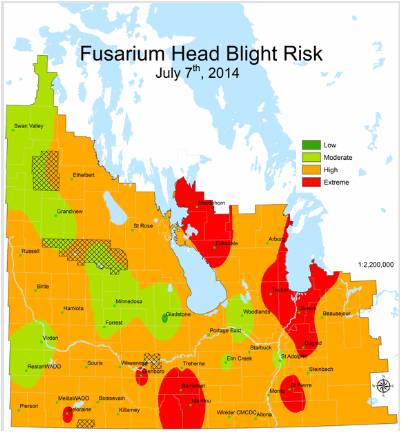
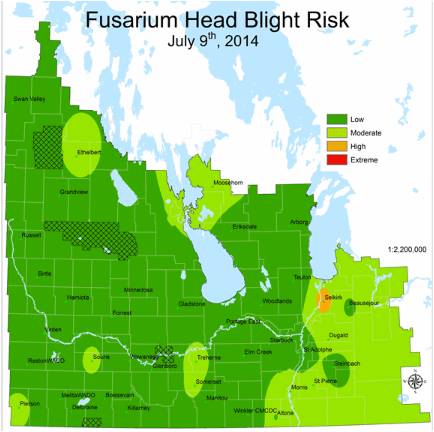
The Fusarium Head Blight Risk Forecast webpage is up and running at http://www.gov.mb.ca/agriculture/crops/fhb/index.html.
Cereal Leaf Beetle
Low levels of cereal leaf beetle have been found in cereal fields near Notre Dame de Lourdes and Carman. Although levels are low, we are interested in collecting samples of cereal leaf beetles to have them examined for a parasitoid, Tetrastichus julis, that is specific to cereal leaf beetles, and can be very effective at maintaining low levels of cereal leaf beetle. So if you do see cereal leaf beetle larvae in a field of any of our cereal grains or grass crops, please consider collecting a sample that can be tested for percent parasitism. Some information on collecting samples and where they can be sent are available in the following factsheet:
If you can not get a sample collected, please contact me (John Gavloski, see contact information at top of page) so we know where cereal leaf beetle is being found and we can see if we can arrange to collect a sample. If there are areas where the cereal leaf beetle is present, but not the parasitoid, I can arrange to do a release of the parasitoids in the area. But we have to submit samples to test for parasitism before we can determine if a release of parasitic wasps should be conducted in the region. So if you do see cereal leaf beetle in your field scouting, please collect a sample or let us know.
Note that larvae of cereal leaf beetle may look yellow, or have an oily appearance, depending on whether their coating (composes partially of their feces) is present or has been removed (through a moult or the larva being disturbed).
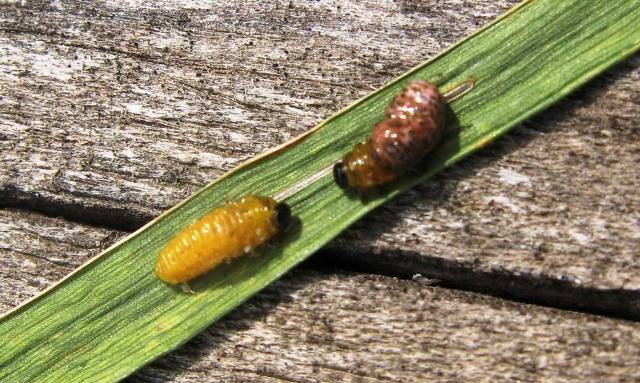
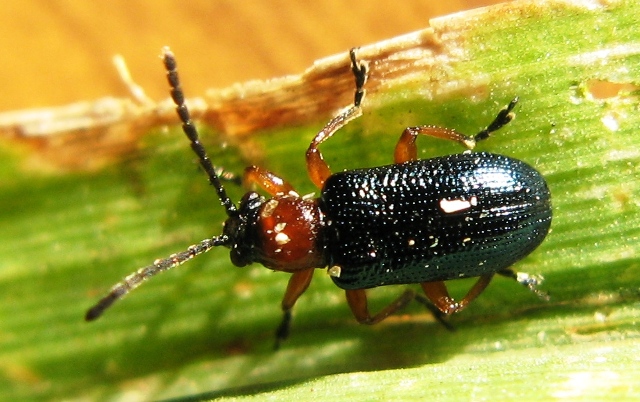
Fig. 6. Larvae of cereal leaf beetle. Fig. 7. Adult of Cereal Leaf Beetle.

